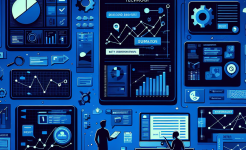Visualizing Project Timelines
One of the primary advantages of Gantt charts is their ability to visualize project timelines. By plotting tasks along a timeline, project managers can easily see when each task is supposed to start and finish. This visual representation helps in identifying overlapping tasks and potential conflicts, allowing for timely adjustments. For instance, if two tasks are scheduled to run concurrently but require the same resources, the Gantt chart will highlight this issue, prompting the manager to reschedule or reallocate resources.
Moreover, Gantt charts provide a clear picture of the project's critical path, which is the sequence of tasks that must be completed on time for the project to stay on schedule. By focusing on the critical path, project managers can prioritize tasks that have the most significant impact on the project's overall timeline. This focus ensures that resources are allocated efficiently, minimizing delays and maximizing productivity.
In addition to visualizing timelines, Gantt charts also facilitate better time management. By breaking down the project into smaller tasks with specific deadlines, project managers can set realistic timelines and avoid the pitfalls of over-scheduling. This granular approach to time management not only improves efficiency but also reduces the likelihood of burnout among team members, as workloads are distributed more evenly.
Enhancing Task Prioritization
Effective task prioritization is crucial for project success, and Gantt charts play a pivotal role in this aspect. By listing all tasks and their respective deadlines, Gantt charts help project managers identify which tasks are most urgent and need immediate attention. This prioritization ensures that critical tasks are completed first, reducing the risk of project delays and ensuring that the project stays on track.
Furthermore, Gantt charts allow for the easy identification of task dependencies. Understanding how tasks are interrelated helps project managers allocate resources more effectively. For example, if Task B cannot start until Task A is completed, the Gantt chart will clearly show this dependency, allowing the manager to ensure that Task A is given the necessary attention and resources. This level of detail in task prioritization leads to more efficient project execution.
Another advantage of Gantt charts in task prioritization is their ability to highlight potential bottlenecks. By visualizing the entire project timeline, managers can identify tasks that may cause delays if not completed on time. This foresight enables proactive measures, such as reallocating resources or adjusting timelines, to prevent these bottlenecks from impacting the overall project. As a result, project managers can maintain a steady workflow, ensuring that all tasks are completed efficiently and on schedule.
Improving Stakeholder Communication
Clear and effective communication with stakeholders is essential for project success, and Gantt charts serve as an invaluable tool in this regard. By providing a visual representation of the project's progress, Gantt charts make it easier for stakeholders to understand the current status of the project. This transparency fosters trust and ensures that stakeholders are kept informed, reducing the likelihood of misunderstandings or misaligned expectations.

In addition to providing a snapshot of the project's progress, Gantt charts also facilitate more productive meetings. Instead of spending valuable meeting time explaining the project's status, project managers can use the Gantt chart as a visual aid to quickly convey key information. This efficiency not only saves time but also allows for more focused discussions on critical issues, leading to better decision-making and more effective problem-solving.
Moreover, Gantt charts can be customized to include additional information, such as resource allocation and task ownership, making them even more useful for stakeholder communication. By providing a comprehensive overview of the project, Gantt charts enable stakeholders to see how their contributions fit into the larger picture. This holistic view encourages greater collaboration and ensures that everyone is working towards the same goals, ultimately improving the project's overall efficiency.
Conclusion
In conclusion, Gantt charts are an indispensable tool for project managers seeking to improve efficiency. Their ability to visualize project timelines, enhance task prioritization, and improve stakeholder communication makes them a vital component of successful project management. By breaking down complex projects into manageable tasks and providing a clear overview of progress, Gantt charts enable managers to allocate resources effectively, monitor progress, and anticipate potential bottlenecks. This structured approach not only ensures that projects are completed on time and within budget but also fosters a more collaborative and productive work environment.
The benefits of Gantt charts extend beyond mere task management; they also contribute to better time management, resource allocation, and stakeholder engagement. By providing a visual representation of the project's progress, Gantt charts help project managers stay organized and focused, reducing the likelihood of delays and miscommunications. Ultimately, the use of Gantt charts leads to more efficient project execution, higher quality outcomes, and greater satisfaction among team members and stakeholders alike.
FAQ
1.What is a Gantt chart and how does it work?
A Gantt chart is a visual tool used in project management to represent tasks, timelines, and dependencies. It works by plotting tasks along a timeline, showing when each task is supposed to start and finish, and highlighting any dependencies between tasks. This visual representation helps project managers allocate resources, monitor progress, and anticipate potential bottlenecks.
2.How can Gantt charts improve stakeholder communication?
Gantt charts improve stakeholder communication by providing a clear, visual representation of the project's progress. This transparency helps stakeholders understand the current status of the project, reducing the likelihood of misunderstandings. Additionally, Gantt charts can be used as a visual aid in meetings, making it easier to convey key information and focus discussions on critical issues.
3.What are the key benefits of using Gantt charts in project management?
The key benefits of using Gantt charts in project management include improved task prioritization, better time management, enhanced resource allocation, and more effective stakeholder communication. By providing a clear overview of the project's progress, Gantt charts help project managers stay organized, anticipate potential bottlenecks, and ensure that tasks are completed efficiently and on schedule.
ARTICLE TITLE :How Does Gantt Chart Help Project Managers Improve Efficiency? ,AUTHOR :ITpmlib

















